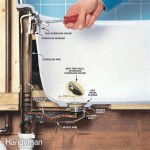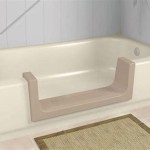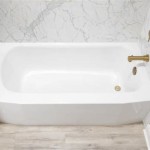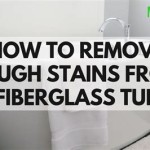Will Baking Soda Damage Your Bathtub? Understanding Its Impact on Different Materials
Baking soda, also known as sodium bicarbonate, is a common household staple lauded for its versatility in cleaning, deodorizing, and even baking. Its mild abrasive and alkaline properties make it a popular choice for tackling various household chores. One area where baking soda is frequently employed is in bathroom cleaning, specifically for addressing stains and grime in bathtubs. However, concerns often arise regarding the potential for baking soda to damage bathtub surfaces. The impact of baking soda on a bathtub depends largely on the material the tub is made from, the concentration and application method of the baking soda, and the frequency of use.
This article will delve into the potential effects of baking soda on various bathtub materials, providing insights into how to safely utilize this common cleaning agent without causing damage. The information presented aims to equip homeowners with the knowledge needed to make informed decisions about cleaning their bathtubs, preserving their longevity and appearance.
Understanding the Properties of Baking Soda
Baking soda is a chemical compound with the formula NaHCO3. It is a white crystalline powder that is soluble in water. When dissolved, it creates a slightly alkaline solution with a pH of around 8.3. This alkalinity is what contributes to its cleaning power, as it can help to dissolve grease, dirt, and other organic matter. Furthermore, baking soda's slightly abrasive texture allows it to physically scrub away stains and residue.
Compared to harsher chemical cleaners, baking soda is generally considered a milder option. However, its abrasive nature should still be considered, particularly when used on delicate or easily scratched surfaces. The effectiveness of baking soda as a cleaner also depends on the type of stain or grime being addressed. It is often more effective on water-soluble stains and organic matter than on stubborn mineral deposits or rust.
The key to using baking soda safely lies in understanding its limitations and employing appropriate application techniques. Overusing it or applying it too vigorously can lead to unintended consequences, especially on certain types of bathtub surfaces.
The Effect of Baking Soda on Different Bathtub Materials
Bathtubs are constructed from a variety of materials, each with its own unique properties and vulnerabilities. Understanding how baking soda interacts with these different materials is crucial for preventing damage during cleaning.
Acrylic Bathtubs: Acrylic bathtubs are popular due to their affordability, lightweight nature, and resistance to chipping and cracking. However, acrylic is a relatively soft material that can be scratched easily. While baking soda is generally considered safe for cleaning acrylic tubs, it is important to use it with caution. Avoid applying baking soda in a dry, abrasive form. Instead, mix it with water to create a paste or solution. When scrubbing, use a soft cloth or sponge and avoid excessive pressure. Abrasive scrubbing pads or brushes should be avoided altogether, as they can readily scratch the surface. Regularly rinsing the tub after cleaning with baking soda is essential to remove any remaining residue, which could potentially dull the finish over time.
Fiberglass Bathtubs: Fiberglass bathtubs are similar to acrylic tubs in terms of their composition and properties. They are made by layering fiberglass strands and resin, resulting in a durable yet relatively soft surface. Like acrylic, fiberglass is susceptible to scratching. Therefore, the same precautions apply when using baking soda to clean fiberglass tubs. Use a paste or solution of baking soda and water, employ a soft cloth or sponge, and avoid abrasive scrubbing. Scratches on fiberglass can be more difficult to repair than those on acrylic, making preventative measures even more important. Furthermore, some fiberglass tubs have a gel coat finish. This coating can be particularly vulnerable to abrasive cleaners. Always test baking soda in an inconspicuous area before applying it to the entire tub.
Porcelain-Enameled Cast Iron Bathtubs: Porcelain-enameled cast iron bathtubs are known for their durability and heat retention. The porcelain enamel is a hard, glossy coating that is generally resistant to scratches and stains. However, older porcelain enamel can become more porous and prone to damage over time. Baking soda can be used on porcelain-enameled cast iron tubs, but it should still be used with caution, especially on older tubs. While the hard enamel is less susceptible to scratches than acrylic or fiberglass, excessive scrubbing with baking soda can still dull the finish over time. It is best to use a baking soda paste or solution and a soft cloth or sponge. Rinse thoroughly after cleaning to remove any residue.
Cultured Marble Bathtubs: Cultured marble is a man-made material consisting of marble dust and resin. It is generally durable and easy to clean, but it can be susceptible to scratching and staining. Baking soda can be used on cultured marble tubs, but it is important to avoid abrasive scrubbing. A paste or solution of baking soda and water is recommended, along with a soft cloth or sponge. It is also crucial to avoid prolonged exposure to baking soda, as it can potentially etch the surface over time. Always rinse thoroughly after cleaning.
Safe Practices for Cleaning Your Bathtub with Baking Soda
To minimize the risk of damage when cleaning your bathtub with baking soda, it is important to follow certain safe practices:
Dilution is Key: Always mix baking soda with water to create a paste or solution. Avoid applying dry baking soda directly to the tub surface, as this can increase the risk of scratching.
Gentle Application: Use a soft cloth, sponge, or non-abrasive brush to apply the baking soda mixture. Avoid using abrasive scrubbing pads or brushes, especially on acrylic and fiberglass tubs.
Avoid Excessive Pressure: When scrubbing, use gentle, circular motions. Avoid applying excessive pressure, as this can increase the risk of scratching or dulling the finish.
Thorough Rinsing: After cleaning with baking soda, rinse the tub thoroughly with water to remove any remaining residue. Baking soda residue can potentially dull the finish over time.
Spot Testing: Before applying baking soda to the entire tub, test it in an inconspicuous area to ensure that it does not cause any discoloration or damage.
Frequency of Use: Limit the frequency of baking soda use. While it is a relatively mild abrasive, repeated use can still contribute to wear and tear on the tub surface.
Consider Alternatives: For delicate surfaces or stubborn stains, consider using alternative cleaning methods or products that are specifically designed for the material of your bathtub. Mild dish soap and water can often be effective for general cleaning.
By adhering to these safe practices, homeowners can effectively clean their bathtubs with baking soda while minimizing the risk of damage. Choosing the right cleaning methods and tools is crucial for preserving the longevity and appearance of the bathtub.
In addition to the material of the bathtub and the application technique, the type of water a household uses can also influence the longevity of a bathtub. Hard water, rich in minerals like calcium and magnesium, can leave behind mineral deposits that are difficult to remove. While baking soda can help with removing some mineral buildup, more aggressive methods might be needed. Regularly removing mineral deposits with appropriate products and rinsing thoroughly can prevent damage to the bathtub surface from harsh cleaning methods.
Ultimately, informed decisions about cleaning practices are important for maintaining the condition of a bathtub. By acknowledging the properties of both the cleaning agent and the bathtub material, and applying appropriate methods, homeowners can ensure their bathtubs remain clean and undamaged for years to come.

How To Clean A Jetted Tub No More Gunk In The Water Bob Vila

Does Baking Soda Clean Bathtubs Marigold Ivy

How To Clean Your Bathtub The Home Depot

How To Clean Your Bathtub The Home Depot

How To Clean Enamel Bathtub A Complete Guide

How To Clean An Acrylic Tub Or Shower 9 Best Cleaners

9 Cleaning Tips To Maintain Your Acrylic Bathtub Streamline

When Not To Go Natural Denver Tub And Bathroom Repairs

How To Clean An Acrylic Tub Or Shower 9 Best Cleaners
Related Posts








